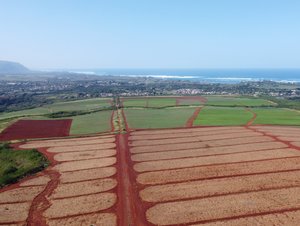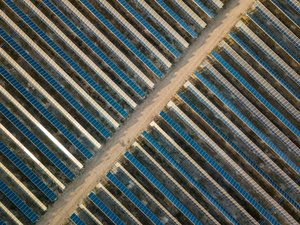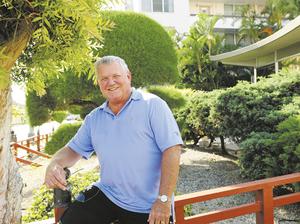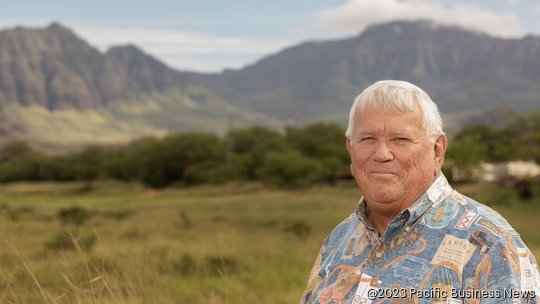
One real estate developer is working to put lands once owned by Dole Food Company — and used to produce sugarcane and pineapple — back in the hands of small farmers. His name? Peter Savio.
On Feb. 18, Savio sold 120 acres of land in Waialua to about 60 buyers as part of the Orchard Planation project. Each acre sold for $130,000, but the commercial price for the same land would be $200,000–$275,000, Savio said.
“This is what I do,” Savio told Pacific Business News. “I am strictly an affordable housing developer. Since I started in development, that’s all I’ve done is trying to help the people in Hawaii solve housing issues.”
This is just one of Savio’s four projects across Oahu aimed at providing farmers with affordable agricultural land at below market rates. The buyers are picked by lottery and more than 1,000 people are on the waitlist, confirmed a representative for Savio. The real estate developer also recently announced his first solar project on Oahu — an 8.5 megawatt solar plus battery storage project slated to go online in 2026 — designed for long-term community ownership.
Savio has more than 60 years of experience in real estate development, with some of his biggest projects including Queen Emma Gardens and Century Park Plaza, which were both 500 to 600 unit projects. Today, his company, Savio Realty Ltd., has four offices and more than 100 agents.
In mid-March, PBN tagged along as Savio toured Ohana Farm Parcels, a 345-acre project where the Sim family, recently selected by lottery, purchased two acres of farmland at below market prices. Walking the red dirt road toward their selected farmland on the Haleiwa side of the Dole Plantation in Wahiawa, husband and wife Taylor and Allyn Sim and their teenage sons — T.J., 17, and Jacob, 15 — joined Savio in taking in the sweeping views of mountains and ocean.
“That’s how you market your crop: Happy vegetables. They had a view,” Savio said.
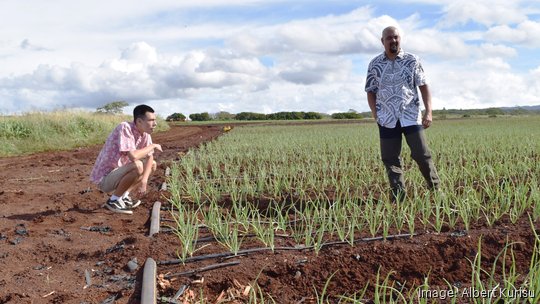
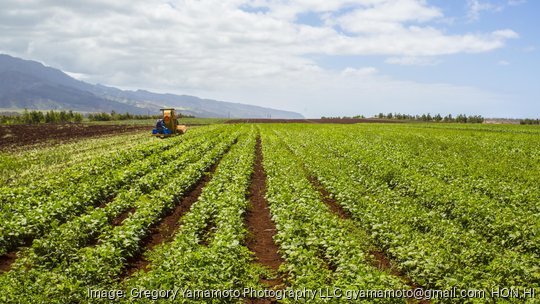
While this property is located in Wahiawa, Savio isn’t restricting affordable agricultural land projects to that area. There is interest from prospective farmers for land in Hawaii Kai and Waianae, he said. Where he sets up agricultural projects depends on farmer interest and land availability, he said.
“We’ve already talked to some people. We’re putting some offers out to buy additional land. If they get accepted, then we’ll start pretty much right away,” Savio told PBN. “Basically, it’s a mad dash between me and the Mainland buyers. If they find out land is available, they buy it. But they buy it, build the house on it, and have this 200-acre country estate. A lot of them are not using it for the local farmers. All of [my developments] are about local farmers, local ownership.”
When the pineapple and sugarcane plantations shut down, Dole were selling 30,000 and 40,000 acres of land, he said.
“Almost all is sold,” Savio said. “So, we’re just picking up whatever we can, if people are reselling — that kind of thing.”
Ohana Farms was bought from another developer who couldn’t sell the land, which had been split into 10-acre lots, Savio added.
“Ten-acre lots are for wealthy guys, not local guys,” he said.
Most of Savio’s projects offer land in one-, two-, three-, four- or five-acre parcels. It’s fee simple land, which means the owner has absolute ownership of property and can resell at any point.
Savio’s foray into real estate started young. In the 1960s, when he was 15, Savio bought his first one-bedroom condominum in the Waikiki Skyliner for $15,750, he said.
“I’m a real estate nut,” he chuckled.
Farmers first
Savio is making some profit on these solar and ag projects but estimates to date, he’s given away about $600 million in profit from selling the land at below market rate and creating camp lots at no profit, he said.
“To me, it’s not about profit,” he said. “I make 5%. Most developers make 20%. So, if I get my 5% — which as a rule I never get, it’s less than that — but it’s about not losing money. That really is the concept.”
The idea for selling agricultural land at below market rate came to Savio when the Waialua Farmers Co-op wanted to buy the Dole-owned property where they worked.
“They came to me and said, ‘Hey, we want to buy our land,’ but they didn’t have a clue how to do it, so I said I’d help them,” Savio explained. “That’s how it started.”
While helping those farmers, Savio realized adding a condo made it easier to finance, he said.
“Once we got into that process, I realized, ‘What do you mean you can’t get financing because they don’t have a house?’” he said. “So I said, in that case, there’s no way you can build on each lot because that’s way too expensive because you got to run power lines and sewer lines. Let’s do a plantation camp, and we’ll put all the houses in one spot. We’ve solved all the problems basically. Now, it’s easier to finance. They have a house they can live in or rent out. They got their farmland.”
In the case of Ohana Farms, the land is currently owned by Aloun Farms. Savio remembers selling farmland to Aloun Sou in Waianae and his son, Alex Sou, then about 12 years old, he said. Now Alex is helping some of Savio’s farmers figure out how to grow their first crops.
“Aloun Farms is one of our larger corporate farmers here in Hawaii and has offered to talk to all of our buyers,” Savio said. “[Alex] actually owns the land now, and he’s selling. And what he’s going to do is he’s going to say, ‘OK, guys, a lot of you are new. I’m going to help you. I’ll show you what to plant. I’ll show you how to plant. I’ll show you where to get the seeds. And I’ll buy your crop, so you don’t have to worry about it.’ And for him it makes sense, because his big problem is finding employees to work the land. It’s a win for everybody. He has the processing center. And he sells to all the supermarkets, Guam, he imports from Australia, sends to the Mainland. They’re kind of automatically going to be hooked in, if they want it — it’s voluntary.”
Aloun Farm will now offer an educational class to all of Savio’s farmers.
“Now, he’s helping me get my farmers started,” Savio said. “That’s Hawaii though, life goes in full circles.”
Since the Sim family works full time during the week, farming will initially be a weekend project.
“It’s tremendous,” Taylor said. “Growing up and even into our adulthood, I thought we would never ever, ever — you know, the prices here — ever, ever [own], unless we just hit the lottery.”
“I’ve never been called the lottery before,” Savio said.
The Sim family almost didn’t get their name drawn during the raffle. Savio called numbers out in batches of 10. The Sim family had the number 7764.
“I think it was one last group of 10,” Taylor said. “We’re just like, ‘you know, no matter what, we had a good day. Whoever got it, good for them.’ ... [He] pulled our ticket. It was seven, seven … six and then I was like ‘he’s not going to say four.’”
But Savio said ‘four’ and Taylor let out a shout of happiness, he said.
The Sim family bought their two acres with savings.
“We always wanted to buy a farm, so every little bit we had, we would just put it away,” Allyn said.
The first-time farmers plan to grow eggplant, beans, breadfruit trees and taro, Taylor said. There will also be a pen of goats, he said. Their oldest son, T.J., will be starting college next year.
“T.J. is even considering changing his major to agriculture,” Allyn said.
As the family walked across the mud and examined existing crops, Savio suggested ways to make their plot prosper.
“Now you gotta play music,” said Savio, referencing the idea that plants grow better when they hear words from people.
“Talk to the plants,” Allyn added.
“The rock ’n’ roll plants can go on one side,” Savio said. “Classics on one side. We won’t split up regular farmers and organic. We’ll split by my music.”
As Savio and the Sim family walked across the red dirt back to their cars, the real estate developer took in the scene.
“Gotta raise the price on this — it’s got ocean view,” he said.
For the Sim family, owning this land is a chance to pass on generational wealth.
“Taylor and I grew up here, right?” Allyn said. “And for us to be able to buy land here and pass it down to our kids means so much to us. It’s really important, and the history that this farmland has in Hawaii and to be able to take care of the land after the people that were here before us – it’s really, really special.” — Katie Helland
Farm Snapshots:

Ohana Farm Parcels
- 345 acres
- Parcels were sold in 5 acre lots
- $44.25 million in total sales volume
- All farm parcels are contracted, pending the condo documents and closing this year.
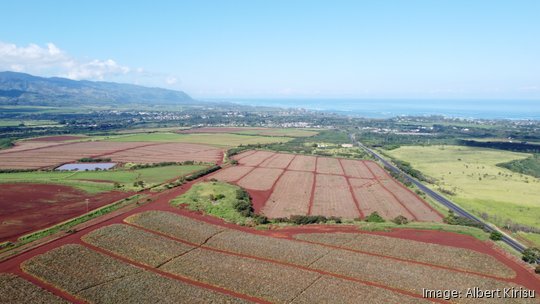
Orchard Plantation
- 155 acres
- Parcels were sold in 2- to- 5 acre lots
- $20.15 million in total sales volume
- All farm parcels are contracted, pending the condo documents and closing this year.
Ranch 1: Farrington Highway at Waialua
- 62 acres
- Parcels were sold in 1.2-5 acre lots
- $8.37 million in total sales volume
Mill 6/10: Puuike Street at Waialua
- 286 acres
- 1.2-5 acre lots
- $6.84 million in total sales volume

Savio Solar Maili
- 198 acres total; 24 of those acres will be devoted to solar
- Buyers will be able to purchase in units of kilowatts to offset their current usage
- The project will be operational in 2026
- Peter Savio is leasing the solar area from the current landowner
*All numbers are approximate
3 questions with Savio on his upcoming solar project
While Peter Savio’s first solar project, Savio Solar Maili – which he describes as a “photovoltaic condominium” – embraces an old concept in terms of a condominium structure, it is a new concept in terms of solar, he told Pacific Business News.
“It’s never been done here before,” Savio said.
Located on the west side of Oahu, Savio Solar Maili is an 8.5 megawatt solar and battery storage farm and is the real estate developer’s first renewable energy project. Savio Solar Maili is one of five new shared solar, or community-based renewable energy projects, first introduced to the public by Hawaiian Electric in March and expected to come online by 2026. Shared solar allows residents without privately-owned rooftop solar the opportunity to subscribe to a local renewable energy facility and receive credits on their monthly electricity bills. Savio Solar Maili is the largest of the projects — the other four of which will be built on Hawaii Island and developed by Pivot Energy, Arion Energy, and Waikoloa Community Solar — and it will be the first utility-scale solar project on Oahu designed for long-term community ownership, as a “photovoltaic condominium,” according to Savio.
Savio, under developer name Savio Solar Power Solutions, held his first community meeting to gain input for the project on April 1 in Maili. While community meetings aren’t required under Hawaiian Electric’s proposal, according to Savio, he feels strongly that he needs to hold meetings to explain to the public what a photovoltaic condominium is. A condominium is a mechanism to share ownership of a man-made asset, he said, which in this case, would be the photovoltaic farm. With Savio Solar Maili, he aims to make local ownership of rooftop solar feasible by allowing for partial ownership of the farm through selling solar panels called “condominium units.” The project is geared toward renters, people who own leasehold businesses, those who live in places without enough roofing, and more, Savio said.
“We’re giving each family the ability to buy whatever panels they need to cover their electric bill,” Savio said. “...The beauty of this program is we’re selling it at cost. I’m going to make a 5% profit. That’s it. So the price should be very favorable. All the benefits should flow to the people.”
Under Hawaiian Electric’s CBRE program, if someone moves from one rental unit to another, the credit will follow them. And in Savio’s project specifically, if they decide to move to the Mainland or somewhere else entirely, they can then sell their photovoltaic condo to someone locally to allow them to reap the solar benefits.
“Solar has been a program that has favored the wealthy. ... And if you think about what we did with the photovoltaic farms, we sold them to wealthy Mainland investors, so all the benefits of solar are flowing out of state,” he said. “In my model, the middleman is gone. The profit motive is gone. So all of the money, all the wealth, should stay within the state.”
How is Savio Solar Maili different from Hawaiian Electric’s other recently announced community based renewable energy projects? The difference is we’re a condo and we’re going to be owned by our lessees. In the other projects, I believe what happens is they’re owned by an investor who sells you power. So if the electric company is charging you 48 cents, they might sell to you for 40 cents. To me, that’s the type of program that people think is helping because it’s called community solar, but it actually means somebody’s making a profit other than the tenant.
To me, that’s not right. This should be where the developer builds it, gets paid a fee for building it, and then he’s gone, and all of the benefits belong to the owners of those solar panels. That’s what we’re structuring. In fact, our project, we’re going so far as to try to make it fee simple [where someone has total ownership of the land]. ... Let’s say the solar farm ends in 30, 40, 50 years. Then they would then be in a position to sell the land. And at that point, they’ll probably get more money on the sale of the land than they did on all the benefits they received over the 30 years. So there’s a huge bonus waiting for them at the end. But again, the key is that wealth is staying in Hawaii with our people. ... The only thing I’m getting is my 5% fee if I don’t make mistakes. If I make mistakes, I get 3% or 2% or something. But there’s not a real profit motive behind what we do. It’s all about making life a little better, making it a little easier and reducing the cost of living.
Have you completed any other solar projects? In 2021, you were planning to sell solar on 20 to 30 acres in Waikele. Do you have any other solar projects on the horizon? This is our first solar [project]. We were going to do it in Waikele, but the project, they classified it as prime ag land, so we felt we’d have trouble getting the necessary approvals. If we’re successful with the condo we’re doing now, I will do as many as I need as long as the demand is there. It’s one of those things that if it works and if it makes the community better and if people want it, we will continue to do it. Just like our ag condos. We started off doing one to help some farmers and then we ended up creating sort of a mini revolution, and now we’re getting ready to start our fifth one now. ... I think the same thing is going to happen for solar.... I will not do a project if the community does not support it. I don’t need 100% approval because you’ll never get 100%, but it’s got to be a pretty good majority. ... If we are successful, I assume we’ll end up building 20 or 30 of them. If you think 60% of our population has to pay electricity and has no affordable voltage, that’s, let’s just say, 600,000 people. If we do the affordable solar farm and help 3,000 households, there are still a lot of households left to go.
What inspired you to sell at market cost? Where did this idea come from? All of my brothers and sisters and I, we’re all very successful in our businesses. We tend to be leaders and innovators. And it was like, why us? ... But I think it’s our parents. My older sister says we didn’t realize how exceptional they were. My father was a top insurance executive here, and he had a chance to be transferred and go to the Mainland and head a large national insurance firm, but he turned it down because he liked living in Hawaii. My mom came into real estate and started off where the first person she called wouldn’t hire her because she was a woman, as it was a man’s business back then. My mother went down and spoke to the gentleman, who ended up hiring my mother. My mom became the first woman who was president of the Honolulu Board of Realtors. She’s the one who broke that glass ceiling.
They were very down-to-earth people, but they had qualities in their personality where it wasn’t about them, it was always about the community and helping people. I think that stuck with all of us. ... We also had Rose Kukuda, who lived with us because she had helped my mom as a babysitter when we lived in Hilo. ... I think the combination of those three people. They were exceptional people, and we were just fortunate that all three of them kind of happened to be in our house and helped to educate and guide us. –Sophia Compton
